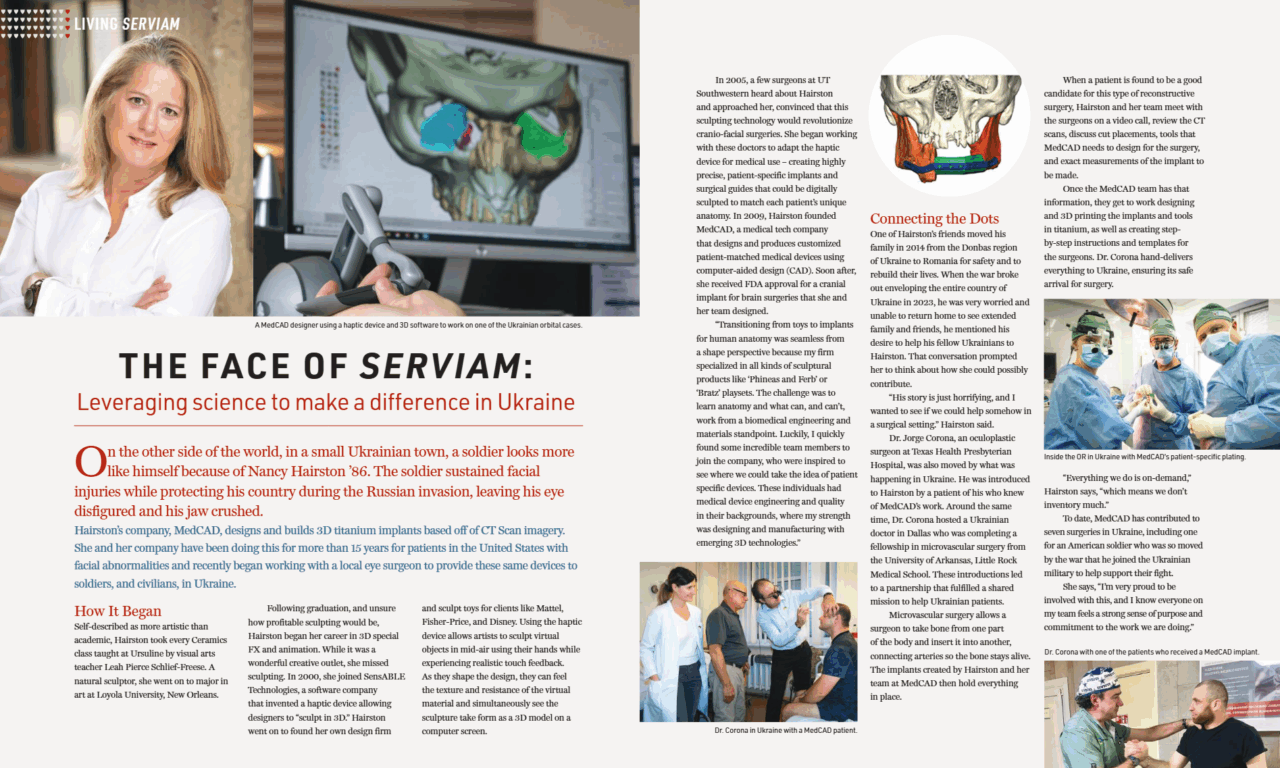
The Face of Serviam: Leveraging Science to Make a Difference in Ukraine
This story was originally written and published by Ursuline Academy of Dallas in the 2025 edition of LOGOS Magazine
On the other side of the world, in a small Ukrainian town, a soldier looks more like himself because of Nancy Hairston ’86. The soldier sustained facial injuries while protecting his country during the Russian invasion, leaving his eye disfigured and his jaw crushed.
Hairston’s company, MedCAD, designs and builds 3D titanium implants based off of CT Scan imagery. She and her company have been doing this for more than 15 years for patients in the United States with facial abnormalities and recently began working with a local eye surgeon to provide these same devices to soldiers, and civilians, in Ukraine.
How It Began
Self-described as more artistic than academic, Hairston took every Ceramics class taught at Ursuline by visual arts teacher Leah Pierce Schlief-Freese. A natural sculptor, she went on to major in art at Loyola University, New Orleans.
Following graduation, and unsure how profitable sculpting would be, Hairston began her career in 3D special
FX and animation. While it was a wonderful creative outlet, she missed sculpting. In 2000, she joined SensABLE Technologies, a software company that invented a haptic device allowing designers to “sculpt in 3D:’ Hairston went on to found her own design firm and sculpt toys for clients like Mattel, Fisher-Price, and Disney. Using the haptic
device allows artists to sculpt virtual objects in mid-air using their hands while experiencing realistic touch feedback. As they shape the design, they can feel the texture and resistance of the virtual material and simultaneously see the sculpture take form as a 3D model on a computer screen.
In 2005, a few surgeons at UT Southwestern heard about Hairston and approached her, convinced that this sculpting technology would revolutionize cranio-facial surgeries. She began working with these doctors to adapt the haptic device for medical use – creating highly precise, patient-specific implants and surgical guides that could be digitally sculpted to match each patient’s unique anatomy. In 2009, Hairston founded MedCAD, a medical tech company that designs and produces customized patient-matched medical devices using computer-aided design (CAD). Soon after, she received FDA approval for a cranial implant for brain surgeries that she and her team designed.
“Transitioning from toys to implants for human anatomy was seamless from a shape perspective because my firm specialized in all kinds of sculptural products like ‘Phineas and Ferb’ or ‘Bratz’ playsets. The challenge was to learn anatomy and what can, and can’t, work from a biomedical engineering and materials standpoint. Luckily, I quickly found some incredible team members to join the company, who were inspired to see where we could take the idea of patient specific devices. These individuals had medical device engineering and quality in their backgrounds, where my strength was designing and manufacturing with emerging 3D technologies.”
Connecting the Dots
One of Hairston’s friends moved his family in 2014 from the Donbas region of Ukraine to Romania for safety and to rebuild their lives. When the war broke out enveloping the entire country of Ukraine in 2023, he was very worried and unable to return home to see extended family and friends, he mentioned his desire to help his fellow Ukrainians to Hairston. That conversation prompted her to think about how she could possibly contribute.
“His story is just horrifying, and I wanted to see if we could help somehow in a surgical setting:’ Hairston said.
Dr. Jorge Corona, an oculoplastic surgeon at Texas Health Presbyterian Hospital, was also moved by what was happening in Ukraine. He was introduced to Hairston by a patient of his who knew of MedCAD’s work. Around the same time, Dr. Corona hosted a Ukrainian doctor in Dallas who was completing a fellowship in microvascular surgery from the University of Arkansas, Little Rock Medical School. These introductions led to a partnership that fulfilled a shared mission to help Ukrainian patients.
Microvascular surgery allows a surgeon to take bone from one part of the body and insert it into another, connecting arteries so the bone stays alive. The implants created by Hairston and her team at MedCAD then hold everything in place.
When a patient is found to be a good candidate for this type of reconstructive surgery, Hairston and her team meet with the surgeons on a video call, review the CT scans, discuss cut placements, tools that MedCAD needs to design for the surgery, and exact measurements of the implant to be made.
Once the Med CAD team has that information, they get to work designing and 3D printing the implants and tools in titanium, as well as creating step-by-step instructions and templates for the surgeons. Dr. Corona hand-delivers everything to Ukraine, ensuring its safe arrival for surgery.
“Everything we do is on-demand,” Hairston says, “which means we don’t inventory much.”
To date, MedCAD has contributed to seven surgeries in Ukraine, including one for an American soldier who was so moved by the war that he joined the Ukrainian military to help support their fight.
She says, “I’m very proud to be involved with this, and I know everyone on my team feels a strong sense of purpose and commitment to the work we are doing.”
